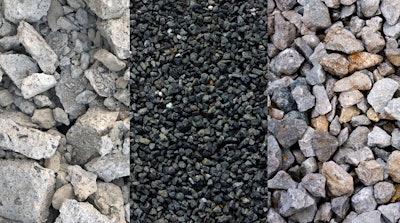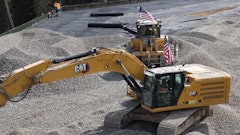
Road infrastructure is an essential component of any society, connecting people and facilitating the movement of goods and services. However, constructing a road requires much more than laying asphalt or concrete.
One critical component of road construction is the road base, which provides the necessary support and stability for the road to withstand heavy traffic and diverse weather conditions. Road base is a layer of material placed on the subgrade. It typically consists of crushed rock or gravel. This layer serves as a foundation for the pavement, helping to distribute the weight of vehicles evenly and prevent cracking or deformation.
This article explores the different road base materials, the factors that influence their selection and the process of constructing a road base. Whether you are a construction professional or just interested in the inner workings of road infrastructure, this article will provide valuable insights into the critical role of road bases in ensuring safe and durable roadways.
Road Base Defined
Road base refers to the material used when constructing roads, driveways, parking areas, paving substrates or anything paved. These materials are compacted tightly together to form a hard surface. Despite the material selected, it is essential that it provides strength and optimal drainage. Below are the most common road base types:
- Gravel: Very fine and has a smooth texture
- Crushed stone: More jagged appearance with different shapes and sizes
- Recycled materials: Made from recycled subgrade base materials like concrete, asphalt and dirt
 Despite the material selected, road base must provide strength and optimal drainage.Jeremy Merchant & Canva Pro
Despite the material selected, road base must provide strength and optimal drainage.Jeremy Merchant & Canva Pro
Road Base in Construction
Road base is a crucial component of the road construction process that serves several functions and benefits. One of the primary functions of road base is to provide strong structural support for the road surface, enabling it to withstand heavy traffic and weather conditions.
This layer of material helps distribute the weight of vehicles evenly, preventing cracking or deformation of the road surface. In addition to load distribution and stability, road base also provides better drainage for the road. By allowing water to drain away from the road surface, road base helps prevent erosion and damage caused by standing water. Adequate drainage is most important in areas with heavy rainfall, snow or tropical storms.
Road base also provides a stable platform for the pavement, reducing the risk of settlement and heaving. This stability is essential in areas with unstable soils or soft subgrades, where the road surface is more susceptible to shifting and deformation. In addition, stability affects road maintenance. Having the proper road base in place requires less maintenance.
Where Road Base Comes into Play
Road base is typically introduced after the subgrade has been prepared and compacted to a stable and level surface. The subgrade, the natural soil that lies beneath the road surface, serves as the foundation for the road base layer. Once the subgrade has been prepared, road base materials can be used.
When installing road base, it must be spread over the subgrade to the required thickness. Then, the materials are compacted using a special machine, such as a roller or compactor. This helps the materials achieve the desired density and stability. This step is essential because it ensures that the road base is compact and provides a solid foundation that is ready for the pavement layer. When installing road base, it must be spread over the subgrade to the required thickness. Then, the materials are compacted using a special machine, such as a roller or compactor.Jeremy Merchant & Canva Pro
When installing road base, it must be spread over the subgrade to the required thickness. Then, the materials are compacted using a special machine, such as a roller or compactor.Jeremy Merchant & Canva Pro
After the road base has been installed, it must undergo testing to ensure that it meets the required standards and specifications. Testing typically involves measuring the density, strength, and permeability of the road base material to ensure that it is suitable for the intended use. Testing may be conducted on samples taken from the road base layer or using nondestructive testing methods, such as ground penetrating radar.
How to Choose the Correct Road Base?
When selecting a road base, several factors must be considered to ensure the road's durability and longevity. These include:
- Local climate—The local weather that the road base will be frequently exposed to is extremely important to consider. A typical Austin, Texas, road base would likely not fare well in upstate New York, for example, as road base in Austin is subjected to high heat and lighter rain compared to a New York highway that will see much lower average temperatures and are subjected to higher rainfall totals, winter weather conditions, and road treatment such as salting and heating to deal with the winter weather. So if the area is typically exposed to rain, snow or heavy storms, a road base that has great drainage properties should be selected. Gravel or crushed stone are great options as each allows water to pass through easily.
- Cost—Different materials used for road base have different prices that should be considered when choosing a road base. Typically, gravel and crushed rock are the least expensive road base materials, while engineered base materials like asphalt, concrete or even glass can be more costly. While cost is a crucial factor to consider when selecting road base materials, it is also essential to consider the long-term costs associated with maintenance and repairs. Low-cost road base materials may save money upfront, but they may require more frequent maintenance and repairs, leading to higher long-term costs.
- Materials available—Depending on the location, road base options may be limited.
- Traffic—For roads or paved areas being constructed in locations with high traffic, it is essential to choose a base that can withstand a heavy flow of traffic. If the wrong base is chosen, the road may need frequent maintenance which can be quite costly due to material and labor. For this reason, it is crucial to consider traffic volume, axle loads, and environmental conditions when selecting road base materials. Thicker and more durable road-base materials may be required for high-volume highways and roads with heavy truck traffic, while roads with lower traffic volumes may be able to use thinner and less expensive road-base materials. Choosing the appropriate road base materials can significantly impact the longevity and safety of the road network, as well as minimize the costs associated with frequent maintenance and repairs.
New Road Base Advancements
Advancements in road base materials are focused on improving sustainability, durability, and cost-effectiveness. One such advancement is the use of recycled materials as road bases. Recycled materials such as recycled concrete and asphalt can be used as base materials, reducing waste and lowering costs while maintaining the same structural integrity as traditional materials. Recycled materials such as recycled concrete and asphalt can be used as base materials, reducing waste and lowering costs while maintaining the same structural integrity as traditional materials.Jeremy Merchant & Canva Pro
Recycled materials such as recycled concrete and asphalt can be used as base materials, reducing waste and lowering costs while maintaining the same structural integrity as traditional materials.Jeremy Merchant & Canva Pro
Another advancement in road base technology is the use of plant-based materials. Plant-derived road base materials are made from organic materials such as wood chips or coconut fibers. These materials can be mixed with traditional materials like gravel or sand to create a more sustainable and cost-effective road base.
Geosynthetic materials are another advancement in road base technology. Geosynthetics such as geotextiles and geogrids can be used to reinforce or stabilize road base materials. These materials can improve the strength and durability of the road base and help prevent damage from heavy traffic or harsh environmental conditions.
Recap
The road base materials selected affect the durability and longevity of roads. The decision depends on factors such as local climate, cost, materials available and traffic volume/type.
Recycled materials, plant-based materials, and geosynthetic materials are among the advancements in road base technology that offer promising alternatives to traditional materials, providing cost-effective and sustainable solutions for road construction and maintenance.
Hunter Kosar is the owner and president of Twisted Nail Sand & Gravel.




















